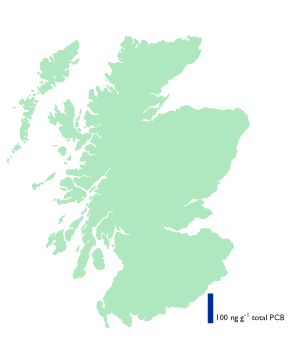PCBs
 First manufactured in 1929, polychlorinated biphenyls (PCBs) found wide industrial uses, chiefly as dielectrics in electrical components. Peak production was reached in the 1960s but concern about their environmental effects began to be arise after their discovery in animal tissues. The chemical nature of PCBs leads to accumulation in fatty tissues and hence to bioaccumulation along food chains. Their toxicity and resistance to decomposition resulted in their restricted use in Britain during the 1970s and finally to their prohibition. Of the total global commercial production of some 1.2 million tonnes it is estimated that about 31% are still present in the environment and have become widely distributed throughout the biosphere and especially in the polar regions. It is thought that redistribution of PCBs on a global scale continues through a volatilisation and deposition process.
First manufactured in 1929, polychlorinated biphenyls (PCBs) found wide industrial uses, chiefly as dielectrics in electrical components. Peak production was reached in the 1960s but concern about their environmental effects began to be arise after their discovery in animal tissues. The chemical nature of PCBs leads to accumulation in fatty tissues and hence to bioaccumulation along food chains. Their toxicity and resistance to decomposition resulted in their restricted use in Britain during the 1970s and finally to their prohibition. Of the total global commercial production of some 1.2 million tonnes it is estimated that about 31% are still present in the environment and have become widely distributed throughout the biosphere and especially in the polar regions. It is thought that redistribution of PCBs on a global scale continues through a volatilisation and deposition process.
The concentrations of PCBs in Scottish soils from the transects were found to be considerably higher than those reported in previous soil studies in England and Wales. The data show an increase in total PCB concentration from north to south that may reflect the spatial distribution of their use and the influence of industrial emissions. The highest values were found in transects 3 and 4 the Central Valley and Southern Uplands, respectively. A characteristic "U" shaped distribution is also apparent across transects 3 and 4 due to higher concentrations in samples close to the coastline. Values in the most Northerly transect are probably closest to the pre-industrial background concentrations (mean 110 ng.g-1).
Reference
Bracewell, J.M., Hepburn, A. and Thomson, C. (1993) Levels and Distribution of Polychlorinated Biphenyls on the Scottish Land Mass. Chemosphere 27 pp1657-1667

